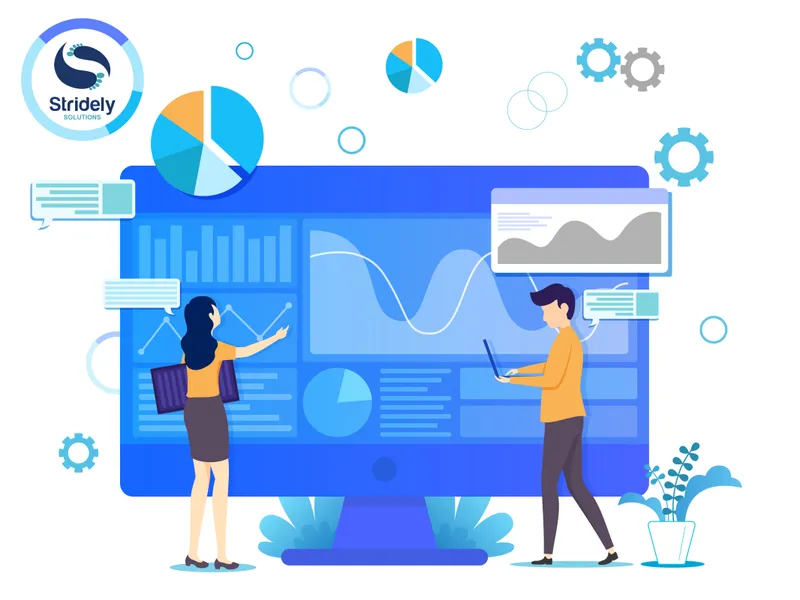

Data Analytics and Business Intelligence: How to Make their Best Combinational Use?
Where Business intelligence solutions focus on interpreting the past data, Data analytics is all about assessing the past data to predict the future. Combination of both would be like they are completing each other.
Technology is ever-growing. Years ago, if you stood by the industrial trend then, it does not imply that you need not redefine it further. Being stuck with a single technology for years would exemplify stagnation.

Picture this –
You are a meal kit company. Impressed by the benefits laid by BI solutions, you redirected all your business marketing campaigns using business intelligence services. And since then, you have hardly made any changes in your business strategies.
Now that technology has taken a steep rise and their bundle of new players, your business is not experiencing steady growth as it was. You are all dusted up. Tried all different ways to lure customers but still, there is something that you are missing out.
How about adding the method of predictive analytics to craft users purchase pattern and then strive to attract them towards similar products?
With more than 6 million connected devices generating a vast amount of data, integrating data analytic solutions to your business would do nothing but good.
Let's see how.
Business Intelligence: Data Analytics - Clearing the Clutter
Now, before we head towards mapping Business Intelligence Services with Data Analytics Solutions, let's have a quick recall as to what these two terms ideally mean -
Business Intelligence
Business Intelligence is the combination of technologies, tools, and methods to collect, integrate and analyze data. The sole purpose of the analysis is to convert raw data into something meaningful which can further be used by business enterprises to make better decisions. Business Intelligence services are primarily fact-based and lay a tremendous impact on the organization's decision making the process both strategically and tactically.
Prime Areas of Implementation:
- Data visualization
- Online Data Processing
- Data Warehouse
Data Analytics
As the term suggests, data analytics is all about analyzing data sets, study them effectively and based on these, help organizations enhance their business productivity. Such data is primarily used to draw conclusions which further lead to the well-determined trends and tracking dependencies. Data analytics solutions are based on quantitative as well as qualitative processes and techniques.
Major Implementation Includes:
- Data Mining
- Predictive Analytics
- Big Data
Why Data Analytics? - Trends That Would Leave You Amazed
Post the symmetrical wave of Business intelligence solutions, the digital industry was exposed to yet another digital transformation as Data Analytics. The technology has been in motion since then. According to a survey, the adoption rate of data analytics has risen from 17% in 2015 to 53% in 2018. No, doubt the technical world is on the face of digital of revolution with Data Analytics being a major player.
From big data to predictive analytics, augmented analysis and IoT integration, Data analytics trends remains a topic of discussion. Shedding some light on the same, let's see what's in store for your organization!
- Machine Learning-Based Artificial Intelligence
Analyzing customer's data just because the technology demands it, is not the idea behind digital transformation. When we say, the revolution we suggest that things would travel beyond boundaries to help your business propel in all situations.
As a matter of fact, data analytics solutions are an ideal way to engage with your existing customers and also create a new one. Machine learning algorithms are capable of detecting a change in users’ behavior and using artificial intelligence techniques, identify customers who are on the verge to leave your business.
Now, if you have been using BI tools, you would never have an idea that you were about to lose your customers. But, with data analytics solutions, tracking customers’ activity is an excellent way to reduce the customers churn rate.
- Predictive Analysis
Knowing data of the past is helpful but not insightful. Like, what would you do just by knowing what was the trend of purchase past year? No doubt, you can assume things but how about getting to know the would-be trend of this year?
Here is where we should use predictive analysis.
It helps analysts keep track of previous data and then draft assumptions and predictions on future behavior. Forecasting trends is an efficient way to target customers and drives sales. Consider - customer purchasing footwear every winter. Now, knowing that winters are arriving, there is a possibility that the customer would again want to make a purchase. This information can be used by marketers to provide attractive offers and lure customers to pay a visit to the store.
- Big Data Analytics
With rising technological modifications, there also rises competition and in order to stay one step ahead, you need to make the most of the technology. Where data analytics solutions draw conclusions to aid decision making, big data deals on a broad scale. It helps scientists keep track of an enormous amount of data and then gain specific insights to help business organization drive traffic and further leverage sales. More or less, big data is the extension of business intelligence and data analytics.
Integrating Business Intelligence Services with Data Analytics Solutions
While the aftermath of the application of data analytics solutions does seem fascinating, the methods and algorithms used to back the same aren't that eye-catching. It involves a range of complex functions and statistical calculations, which of course isn't readable by all. However, there are few techniques which facilitate the integration of Business intelligence solutions with data analytics.
- Regression Analysis: Given a statistical model, regression analysis deal with mapping variables based on a significant relationship. In simple words, this method allows the analyst to draft a relationship between two or more variables. It further determines the data dependency that helps organizations take a better decision.
- Cohort Analysis: Practically the subset of behavioral analytics, cohort analysis integrates data in separate chunks. For instance, if there is a manufacturing company, users’ data is divided based on geographic location, time of purchase and other relevant aspects. This form of analysis does not seek data as a single unit, instead, segregate them into different groups and then analyze each group separately to further target them. Division of groups is based on similar characteristics or purchase behavior. This leads to dissecting customers effectively, analyze their patterns and then direct marketing tactics to leverage sales.
- Time Series Analysis: This is more of a graphical, representation of data against time. In order to predict future sales, you need to first trace the previous year's sales pattern with data against time. This helps analyst get a better view of purchase patterns of users, see when does the graph shows the maximum decline and then plan accordingly.
Closure
Where Business intelligence solutions focus on interpreting the past data, Data analytics is all about assessing the past data to predict the future. Combination of both would be like they are completing each other. Sure, your business would have created records after BI solution integration but this does not suggest you halt there. It's always a good idea to keep track of technological advancement and upgrade your business, at all possible times.





.jpg?mode=crop&crop=faces&ar=1%3A1&format=auto&w=1920&q=75)

